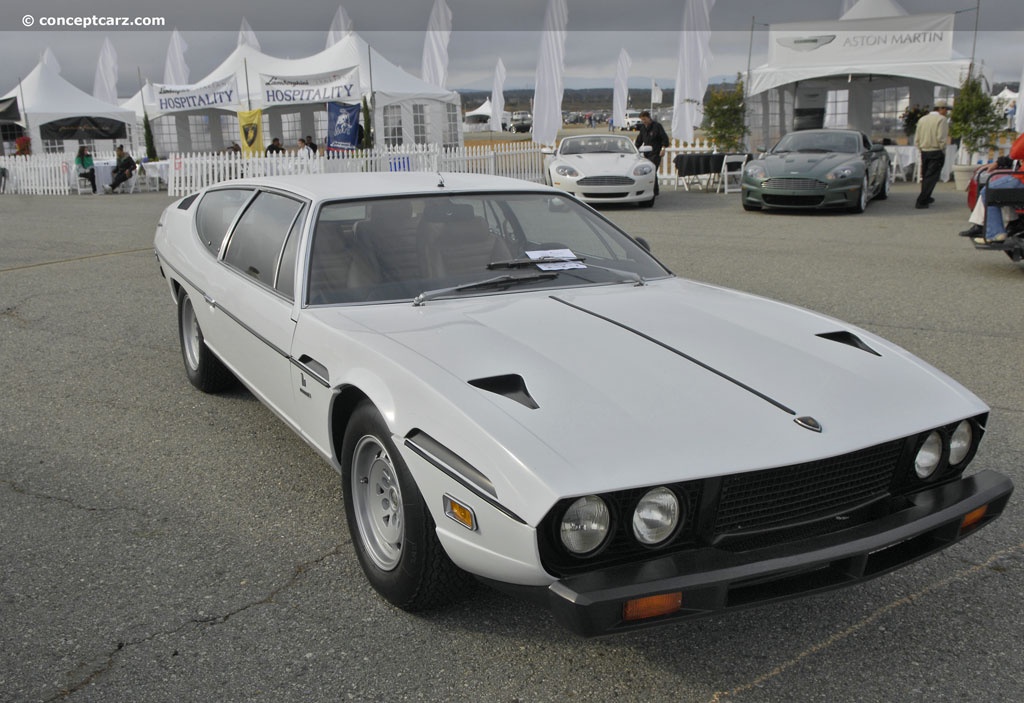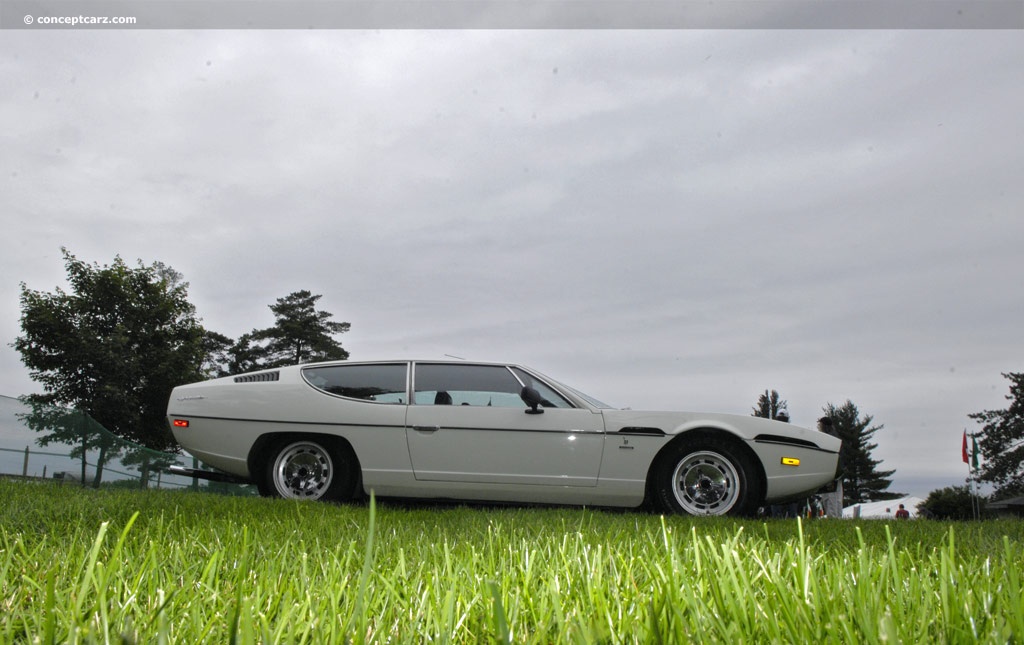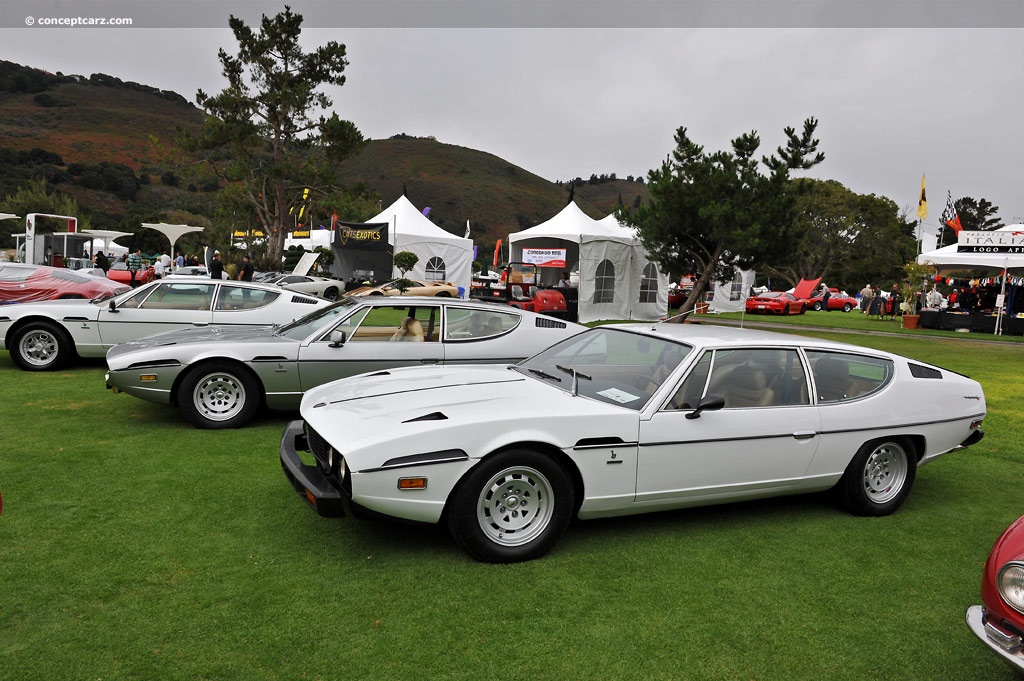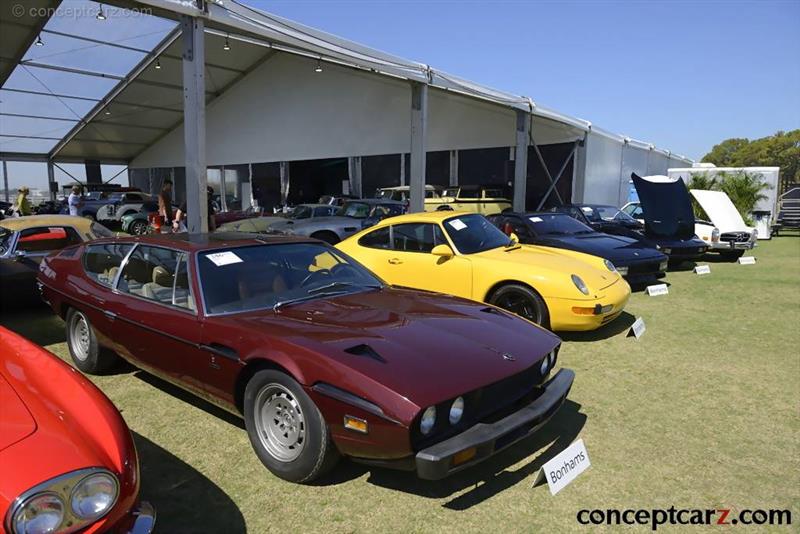It was the Marzal show car, displayed at the 1967 Geneva Auto Show, and the Bertone Pirana from which the Lamborghini Espada was based, filling the void in the company's lineup for a proper four-seater automobile. At the time, the Lamborghini model lineup included the two-door Lamborghini Miura sports car (in production from 1966 to 1973) and the Touring-styled 350 GT, built from 1964 to 1966. The 350GT was powered by a 3.5-liter, four-cam V12 engine designed by Giotto Bizzarrini, housed in a chassis penned by Gianpaolo Dallara. With four camshafts and an all-independent suspension, the 350GT upstaged the best that Ferrari offered at the time. The 350 GT was replaced by the 400 GT (400 GT Interim) and forthcoming 400 GT 2+2 which had a larger body shape to accommodate the occasional +2 seating. 1968 witnessed the arrival of the Islero to the Lamborghini lineup, serving as a replacement for the 400 GT. The new grand tourer was introduced at the Geneva Auto Show in 1968 wearing a design created by Mario Marazzi at Carrozzeria Marazzi. Both the Islero and Espada rested side-by-side at the Geneva Auto Show and both featured a 2+2 coupe body style, however, the styling of the Islero was more restrained while the Espada was more radical.
CoupeThe name Espada translates as 'sword' in Spanish, depicting the sword of bullfighters. The design of the Espada was courtesy of Marcello Gandini of Bertone and was similar to the stillborn, rear-engined, six-cylinder Marzal, but its 4.0-liter, four-cam V12 engine was placed at the front. The prototype Espada was built using the wooden body buck used for the Jaguar Pirana concept car. Features included a low nose, the gullwing doors of the Marzal, and large side windows. The Espada's engine was first used in the 400GT and also by the contemporary Islero. Both the Islero and the Espada had 325 horsepower of propulsion, with the Espada capable of achieving a top speed of 150 mph while the Islero was rated at 154 mph. The Lamborghini-designed five-speed manual transmission was equipped with synchromesh and a hydraulically operated dry clutch. The transmission was mounted longitudinally, inline with the engine, and its internal components were identical to those of the Islero and the Miura. The transmission casing was also the same as the Islero, but different from the Miuras, as it used a transverse mid-engine configuration. The Series III Espada, from 1974 forward, could be purchased with an optional Chrysler TorqueFlite 3-speed automatic transmission. Approximately 55 examples of the Espada were so-equipped.Both the Islero and the Espada's engine were equipped with six Weber 40DCOE side-draft carburetors, wet-sump lubrication, and a single distributor for ignition. Aluminum alloy was used for the crankcase while the cylinder liners were formed from cast iron and the pistons from aluminum. There were two valves per cylinder for a total of 24, and two chain-driven overhead camshafts per bank. The 3,929cc displacement size was achieved by the 82mm bore and 62mm stroke. The Series 1 Espada's used a 9.5:1 compression while the Series II and III engines had 10.7:1 compression. The output of the Series II and III cars were reported at 350 horsepower at 7,500 RPM.
Coupe
Chassis #: 9220
View info and historyIslero running gear was employed but wedded to a platform-type, semi-monocoque chassis rather than the former's tubular frame. The suspension was based on the 400 GT 2+2, with coil springs, hydraulic shock absorbers, anti-roll bars, and unequal length double wishbones. At the top front of the chassis was a worm-and-peg steering system manufactured by ZF. Power steering did not become available until the Series III Espadas. Twin fuel tanks carried 25 U.S. gallons of fuel, with two fuel fillers discretely hidden beneath the black cosmetic grilles in both C-pillars. Disc brakes by Girling were placed at all four corners, initially being solid, but replaced by ventilated discs for the Series II. Series I and II Espadas received Pirelli Cinturato 205VR15 tires (CN72) with SEries III rolling on Cinturato 215/70VR15 (CN12) tires.The Series I Espada
Lamborghini produced 186 examples of the Series I before January 1970, accounting for approximately 6% of the 1,217 total Espadas produced. Distinguishable features included the same taillights that were used on the first series Fiat 124 Sport coupe, and the interior dashboard was inspired by the Marzal concept car, with octagonal housings for the primary instruments. An additional binnacle housed the secondary gauges. Its 3,929cc twelve-cylinder engine offered 325 horsepower.The Series II Espada
Lamborghini introduced the Series II Espada in 1970 at the Brussels Motor Show and these were the most popular of the three Series with 575 examples eventually built. On the exterior, distinguishable features were minimal, with the removal of the grille covering the vertical glass tail panel being one of the only noticeable changes over the SEries I. The engine received higher compression of 10.7:1 resulting in a boost in horsepower to 350 hp. The solid disc brakes were replaced with vented Girling discs, and CV joints were added to the rear half-shafts. The interior gained an all-new dashboard and center console, with the instrument binnacle haivng a move conventional rectangular shape. The gauges were now rounded, and the wood-trimmed fascia now traversed the entire width of the dashboard. With a nod to luxury, the rear seat passenger ventilated was improved, making grand touring more enjoyable for all occupants. A few later-built Series II Espadas received new wheels on five-stud hubs, replacing the earlier knock-off wheels. These new wheels were carried over to the Series III.The Series III Espada
The third and final iteration of the Espada arrived in 1972 riding on the newly introduced wheels and using the same 350 hp engine. Air conditioning and ZF power steering were now standard, and in 1974, a Chrysler TorqueFlite 3-speed automatic transmission became optional. A sunroof was also new to the options list. Wider Pirelli Cinturato 215/70WR15 CN12 tires were placed at all corners, the front grille now had a square mesh, and the new taillights were courtesy of the Alfa Romeo 2000.
CoupeOnce again, Lamborghini revised the interior with a redesigned aluminum-trimmed instrument panel.To comply with newly introduced safety requirements in the United States, large impact bumpers were added in 1975. Mechanical changes were made to satisfy US emission requirements, including the addition of a secondary air injection pump and tuning of the carburetors. Production continued through 1978 with approximately 456 examples of the Series III being produced during that time.
by Daniel Vaughan | Apr 2022

Coupe

Coupe
Chassis #: 9220
View info and history
Lamborghini produced 186 examples of the Series I before January 1970, accounting for approximately 6% of the 1,217 total Espadas produced. Distinguishable features included the same taillights that were used on the first series Fiat 124 Sport coupe, and the interior dashboard was inspired by the Marzal concept car, with octagonal housings for the primary instruments. An additional binnacle housed the secondary gauges. Its 3,929cc twelve-cylinder engine offered 325 horsepower.The Series II Espada
Lamborghini introduced the Series II Espada in 1970 at the Brussels Motor Show and these were the most popular of the three Series with 575 examples eventually built. On the exterior, distinguishable features were minimal, with the removal of the grille covering the vertical glass tail panel being one of the only noticeable changes over the SEries I. The engine received higher compression of 10.7:1 resulting in a boost in horsepower to 350 hp. The solid disc brakes were replaced with vented Girling discs, and CV joints were added to the rear half-shafts. The interior gained an all-new dashboard and center console, with the instrument binnacle haivng a move conventional rectangular shape. The gauges were now rounded, and the wood-trimmed fascia now traversed the entire width of the dashboard. With a nod to luxury, the rear seat passenger ventilated was improved, making grand touring more enjoyable for all occupants. A few later-built Series II Espadas received new wheels on five-stud hubs, replacing the earlier knock-off wheels. These new wheels were carried over to the Series III.The Series III Espada
The third and final iteration of the Espada arrived in 1972 riding on the newly introduced wheels and using the same 350 hp engine. Air conditioning and ZF power steering were now standard, and in 1974, a Chrysler TorqueFlite 3-speed automatic transmission became optional. A sunroof was also new to the options list. Wider Pirelli Cinturato 215/70WR15 CN12 tires were placed at all corners, the front grille now had a square mesh, and the new taillights were courtesy of the Alfa Romeo 2000.

Coupe
by Daniel Vaughan | Apr 2022
Related Reading : Lamborghini Espada History
The Lamborghini Marzal show car sat atop a longer Miura chassis and given a six-cylinder engine in vee configuration and mounted mid-ship. It was shown at the 1967 Geneva Auto Show. The Lamborghini Pirana was a show car that sat atop a Jaguar E-Type chassis. Both were designed and built by the famous coachbuilder Bertone. The Lamborghini Espada draws its styling cues from both of these concepts.....
Continue Reading >>
Continue Reading >>
Similar Automakers
Similarly Sized Vehicles
from 1974
1974 Lamborghini Espada 400 GT Vehicle Profiles
Recent Vehicle Additions
Performance and Specification Comparison
Price Comparison
Espada Specification Comparison by Year
Year
Production
Wheelbase
Engine
Prices
Related Automotive News

Stunning 718 RSK and Selection of Significant Porsches Set to Headline Gooding & Company's Return to Amelia Island
The auction house returns to Amelia Island with an outstanding 1959 Porsche 718 RSK alongside an ultra-rare 1993 Porsche 964 Carrera RS 3.8 and a pristine 2005 Porsche Carrera GT.
Gooding %26 Company is proud to return to Florida for its 12th annual...

An icon reborn – technology leader Everrati™ unveils 500bhp 'Signature' wide body model, a redefined Porsche 911 with futureproof EV power
Everrati™s latest electric supercar is a redefined Porsche 911 (964) wide body
500bhp, 500Nm, sub-4-second 0-62mph acceleration, 150 mile range
Lighter than original thanks to the use of carbon fibre body panels
Engineered by an elite team rec...

The Best Of Lamborghini At London Concours 2020
The London Concours has announced its Great Marques Lamborghini display, celebrating the very best from SantAgata
Line-up includes icons early pioneers like the 400GT and iconic Miura, through to the Diablo SV, Murcielago and Aventador SVJ
Les...

Maserati Celebrates The 50Th Anniversary Of The First Indy Coupé Delivery
Modena, 1 July 2019 – The 1st of July 1969 is an important day in the history of Maserati, since the first Indy built for a customer left the Trident Brands historic headquarters at via Ciro Menotti 322 in Modena, heading for delivery in Switzerland....

THE McLAREN F1
FOR THE DRIVER VITALLY – AS IN ONE OF McLARENS WORLD CHAMPION RACING CARS – DRIVER AND VEHICLE BECOME ENTIRELY AS ONE
The primary design consideration for the McLaren F1 has been to make it without reserve a drivers car, an extremely high-performance...



































